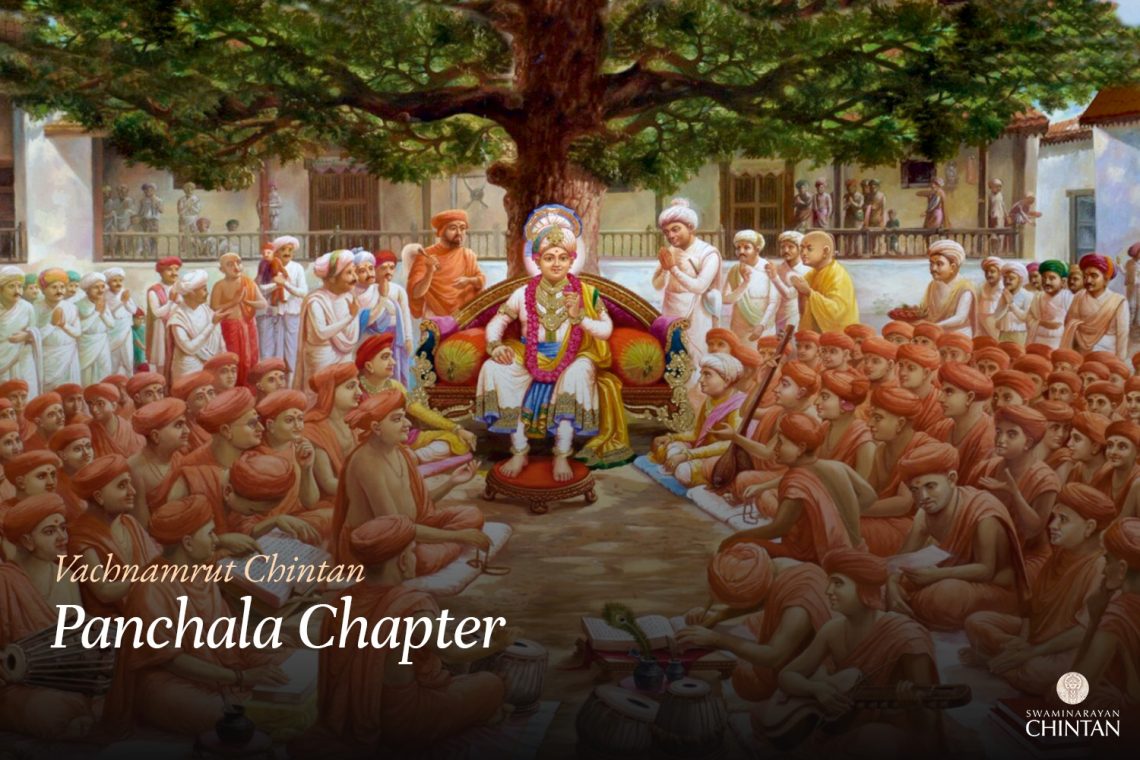Central Insights:
- Developing firmness in Upasana
Main Points:
- Since Shree Krishna Bhagwan displayed the essence of all forms within Himself, His incarnation is considered the greatest among all.
- Shreeji Maharaj also displayed all the qualities of Krishna’s incarnation within His own form, and beyond that, He exhibited qualities that were not shown in that incarnation. Therefore, one should worship Maharaj, knowing Him as the source of all incarnations.
Commentary:
This Vachanamrut emphasizes the importance of firmness in Upasana. What does it mean to have firmness in Upasana? It means to firmly believe that the Maharaj we have encountered is the master of all realms of creation, and to worship Him with this firm conviction. This is what is called firmness in Upasana. Maharaj explained this concept by providing the example of the Krishna incarnation. Maharaj states that after reviewing all the Shastras, it became evident that no other incarnation has been as fully endowed with all divine powers as Shree Krishna. Other incarnations remain in their distinct forms, but Shree Krishna Bhagwan displayed the attributes of all forms within Himself.
In the Upanishads, the Rishis gather and inquire, केश्च ध्याेय:? — Kaśca Dhyeya? “Whom should we meditate upon?” Then, after thorough contemplation, they conclude, “The cause of creation should be meditated upon” कश्च ध्येयः कारणं तु ध्येय — kaśca dhyeyaḥ kāraṇam tu dhyeya; Another question arises: “Who can be considered the cause of creation?” The resolution is found in the Brahmasutra: यतो वा इमानि भूतानि जायन्ते। येन जातानि जीवन्ति – जन्माद्यस्य यतः — yato vā imāni bhūtāni jāyante. yena jātāni jīvantī – janmādyasya yataḥ (Brahmasutra 1-1-2), meaning the one who creates countless universes for the sake of the salvation of jeevs is indeed considered the cause of creation. The same principle is discussed in the teachings of Gunatitanand Swami, where it is stated that after creating each Brahmand, Bhagwan placed ten divine forms in each universe for the sustenance of the universe and for the spiritual well-being of the world. Thus, Bhagwan manifested ten forms in each universe—four of them being Nirgun (without attributes) and the remaining as Saguna (with attributes). Maharaj makes a similar point in this Vachanamrut, emphasizing that the greatness of one incarnation over another lies in the fact that a supreme incarnation can reveal the divine forms and powers of multiple forms within His own form. He can display the divine powers of all Vibhutis under His control, and, through the manifestation of His supreme might, He performs the tasks of the incarnation. Such an incarnation is considered to be fully endowed with all divine powers or is regarded as a greater incarnation compared to others.
Maharaj explains here that during the divine activities of His incarnation, Shree Krishna Bhagwan first revealed Himself in His four-armed form, Vaikunthnath (Lord of Lakshmi), to Vasudev and Devaki. He then showed the entire Brahmand in His mouth to mother Yashoda, thereby displaying the thousand-headed form of Aniruddha. He gave Darshan (divine vision) to Akrur in the Yamuna as Sheshshaiya (the one who reclines on the serpent Shesh). On the battlefield, He revealed His universal form to Arjun, showing Himself as the Virat Narayan. Additionally, Shree Krishna Himself was none other than Radhakrishna, the divine couple residing in Golok. He also appeared to Arjun as Bhoomapurush and, in Shwetdweep, was none other than Vasudev. Moreover, Nar Narayan is referred to as Shree Krishna throughout the whole of Bharat.
Shree Krishna Bhagwan displayed all the divine powers, Vibhutis, and energies of the different realms of creation within His own form through His supreme, otherworldly divinity. He showed the divine images of the significant abodes, such as Badrikashram, Shwetdweep, Vaikunth, and Golok, within His own form. Additionally, during His divine acts of incarnation, He displayed the Vibhutis, powers, and divine splendor of these abodes on various occasions. However, He did not merge into any of these forms nor become subordinate to any of the divine powers. Therefore, no other incarnation matches His supremacy. When one worships the form of Bhagwan, understanding Him as the cause of the entire creation, the controller of all Vibhutis, and the bearer of all the divine splendors of the supreme abodes, that is considered true Upasana.
In connection with this Vachanamrut, after reflecting on the divine actions of Maharaj and witnessing His complete and perfect incarnation, it is up to us to decide how we should understand Maharaj. Just as Maharaj used the example of Shree Krishna Bhagwan to explain this concept, we must similarly contemplate whether Maharaj’s actions in His divine pastimes and life’s work surpass even those of Shree Krishna. We should understand Maharaj in this way and worship Him accordingly.
In the context of Samadhi episodes and on various occasions, Maharaj revealed other divine forms within His own murti (divine form). He demonstrated the Vibhutis and divine powers of other dhams (abodes) through His own greatness and revealed aspects in His murti that other incarnations could not display. When we gather and compare all of these divine revelations, it will naturally stir within us the realization of who Maharaj truly is. Once we worship Maharaj with this understanding of His supreme glory, it is called Upasana.
Maharaj says that a devotee who remains unwavering in their intellect regarding the form of Shree Krishna (Maharaj) will never fall from the path of salvation and will undoubtedly attain their ultimate good. What does it mean to have firm conviction in the direct form of Shree Krishna? The conclusion of the Vachanamrut makes it clear: “All the Santo (saints) and devotees had firm conviction in the ultimate supremacy of Shreeji Maharaj.” Maharaj explains, “One whose heart holds firm conviction in this understanding may face obstacles, but they will never fall from the path of salvation. However, if there is any weakness in that conviction, it will not be easily corrected in any way” (Vach.G.M.13).
Glossary
| Upasana – Worship and devotion The practice of deep meditation and attachment to Bhagwan. |
| Vibhuti – Divine powers or manifestations The glories, energies, and powers that Bhagwan reveals or embodies in different forms. |
| Murti – Divine form of God Refers to Bhagwan’s physical or imagined divine form, which provides joy and spiritual connection during contemplation. |
| Brahmand – Universe |
| Akshardham – The eternal supreme abode of Bhagwan Swaminarayan The divine realm where Bhagwan Swaminarayan resides along with Akshar Muktas (Divine Liberated Souls) |
| Vaikunth – The Divine abode of Vishnu |
| Golok – The divine abode of Bhagwan Krishna |
| Shwetdweep – The divine abode of Vasudev Bhagwan A celestial abode for those with a high level of devotion. |
| Badrikashram – The sacred divine place for spiritual practice where Narnarayan Bhagwan resides A revered place for meditation and austerity, particularly associated with performing spiritual practices without worldly distractions. |
| Nirgun – Beyond the three qualities of Maya |
| Sagun – With divine attributes The form of Bhagwan manifest with attributes to relate to devotees; includes compassion, justice, and form. |
| Brahmasutra – A key philosophical vedic text A scripture written by Bhagwan Ved Vyas that discusses the principles of creation, the nature of the soul, and the path to liberation. |
| Janmadyasya Yatah – “From whom all creation arises” A phrase from the Brahmasutra used to identify the ultimate cause as Bhagwan. |
| Darshan – Divine vision or sight |
| Virat Narayan – The universal form of God |
| Samadhi – Deep meditative state A state of deep, focused meditation, where the body remains unconscious and the mind is absorbed in God and divine experience |

